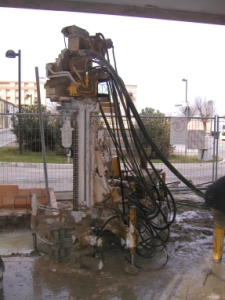 A micropile is a foundation pile with a diameter of 90-250mm and a length of 12-15m.
A micropile is a foundation pile with a diameter of 90-250mm and a length of 12-15m.
Micropiles are preferred to piles when urban areas are concerned, due to the considerable size of the operating machines that require big workspaces and storage. Also, the proximity of buildings or the presence of balconies and eaves makes it difficult to use piles.
In such circumstances, the micropiles become the more adequate technology solution for land reclamation.
The micropile load-bearing capacity is not comparable to that of a medium size diameter pile (250-800); if needed and taking into account the small size, it is possible to obtain a stable and little saggy background support by using a greater number of micropiles arranged in a regular grid on which place a plate foundation.
The connection to the foundation is done through the incorporation of the micropile head within the superficial foundation structure, allowing the absorption of any moment actions.
Applications
Indirect foundation has many applications and is required in many occasions:
- In the consolidation of direct foundations with insufficient bearing capacity to support the superstructure;
- In the restoration and/or repair of foundations damaged by external physical-chemical agents (settlements, erosion at the foot of bridge piers);
- In the consolidation of lands before execution of direct foundations;
- In the realization of tie rods/anchors (applications in rock fall barriers and tie rods for the variation of the tilting of bulkheads).
The most common use of micropiles in urban areas is to build bulkheads and/or diaphragms known as “berliners”, since the size of the necessary equipment is small.
The bulkheads consist of a series of micropiles of appropriate length disposed along a straight line (staggered grid called “quinconce”) and built at variable center distances (from 30 to 70 cm), depending on the soil characteristics and the excavation heights.
The bulkheads are widely used for the support of the excavation face, allowing to operate safely and safeguarding other people’s property; they are a viable alternative to concrete diaphragms, steel sheet piling, jet grouting diaphragms and pre-fabricated bulkheads, etc.
Berliners are widely used in urban environments because, during the works, the drilling of micropiles:
- do not induce vibrations in the ground (driving of sheet piles);
- do not use bentonites for the support of the hole (diaphragms in c.a.);
- do not pollute acoustically (pile driver for prefabricated diaphragms cac).
Micropiles are generally created on site (not pre-fabricated), with small equipment (hydraulic probes, drillers) that permit the execution inside buildings. In spacious outdoor construction sites, drill rigs of considerable size and weight up to 300 quintal are used.
Execution phases
- Positioning of the equipment on the drilling point and verification of design required parameters (verticality, position…);
- drilling execution (with tools as down-hole hammers, propellers, tricone, drag bits, hole openers with variable diameters and different drilling technologies depending on the characteristics of the soil), adding at the same time bentonite mud, to prevent the excavation from getting clogged in the walls of the pit created;
- set up of tubular metal armor (metal tube);
- injection of the cementitious mixture under pressure (concrete with high dosage of cement, mixtures consisting of water, cement and bentonite) from the bottom to the top through a tube situated inside the tubular armor. As the cement mixture surges, the bentonite can be recovered.
Through the injection at different pressures it is possible to increase the size of pile base (bulb) to obtain a higher vertical load bearing.
Bearing capacity
The micropile with “indirect foundation function” can provide requested load bearing (from 10 to 100 tons) in two different ways, also used in combination:
- base bearing: when the foundation reaches the desired depth, whether it settles on a layer of soil with high load-bearing capacity or using repeated and selective injection techniques, a large contact area called bulb, is created at the base of micropile.
- lateral bearing: the foundation uses the friction of the side surface with the ground to reach degree of lift required for the project.
- base bearing submitted to lateral bearing: the foundation makes the most of the deepest layer power and the lateral friction with the ground.
